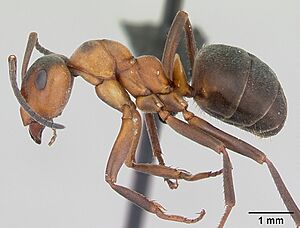Scottish wood ant facts for kids
Quick facts for kids Scottish wood ant |
|
|---|---|
 |
|
| F. aquilonia worker | |
| Conservation status | |
| Scientific classification | |
| Genus: |
Formica
|
| Species: |
aquilonia
|
The Formica aquilonia, also known as the Scottish wood ant, is a type of wood ant. These ants belong to the Formica group. You can find them across many parts of Europe and Asia. They live from cold Scandinavia in the north all the way to Bulgaria and Italy in the south. They are also found from the UK east through France, Germany, and into Russia. You can even spot them near the Sea of Okhotsk in eastern Siberia. Scottish wood ants mostly live in coniferous forests, which are forests with trees like pines and firs. Sometimes, they also live in deciduous woodlands, which have trees that lose their leaves in autumn.
Contents
What Does the Scottish Wood Ant Look Like?
The Scottish wood ant has a unique look. Its head and the middle part of its body, called the thorax, are reddish-brown. Its back part, the abdomen, is black. If you look closely at the back of its head, you'll see a short line of hairs. These hairs do not reach as far as its eyes. This ant has fewer and shorter hairs compared to other types of wood ants found in Britain.
Where Do Scottish Wood Ants Live?
Scottish wood ants are found across a large area in northern Europe. Their home range stretches from Scandinavia all the way to Siberia. They also live in cooler, mountainous areas of central Europe and Asia.
In Scotland, these ants are common in the pinewoods of the Caledonian Forest. You can also find them throughout the Scottish Highlands, including the Isle of Skye off the west coast. They have also been seen in two places in County Armagh in Northern Ireland. These ants usually prefer coniferous forests. They can be found in open areas within these forests, like clearings and paths, and in tree plantations.
How Do Scottish Wood Ants Behave?
Scottish wood ants are known for building very large nests that look like mounds. During the day, you can see long lines of ants moving out of these nests. They climb up trees and connect their home nest to other nests nearby.
These ants are busy foragers. They collect a sweet liquid called honeydew. This honeydew is made by tiny insects that live on tree leaves. The ants bring the honeydew back to their nest to share. They also collect other food, like living or dead insects, to make sure they have enough to eat.
Ant Reproduction and New Nests
In the summer, special winged ants are born. These are the ants that can reproduce. New ant nests can also start when a group of ants, including some queens, moves away from a parent nest. This is called fission. A single parent nest can sometimes have many queens living together.
Why Are Scottish Wood Ants Protected?
The Formica aquilonia is listed on the International Union for Conservation of Nature's (IUCN) Red List. This list helps us know which animals and plants might be at risk. The Scottish wood ant is currently classified as "Lower Risk." This means they are not in immediate danger, but we still need to keep an eye on them.
Because people are worried about their future, there are special plans to help protect them. These are called Species Action Plans. They are part of the UK's plan to protect biological diversity, which means all the different kinds of life on Earth. In Northern Ireland, this ant is very rare. Because of this, it is listed as a Northern Ireland Priority Species, meaning it needs special attention and protection there.
See also


